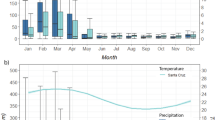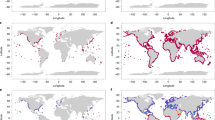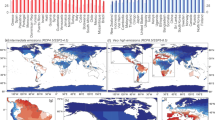Abstract
Most of the policy debate surrounding the actions needed to mitigate and adapt to anthropogenic climate change has been framed by observations of the past 150 years as well as climate and sea-level projections for the twenty-first century. The focus on this 250-year window, however, obscures some of the most profound problems associated with climate change. Here, we argue that the twentieth and twenty-first centuries, a period during which the overwhelming majority of human-caused carbon emissions are likely to occur, need to be placed into a long-term context that includes the past 20 millennia, when the last Ice Age ended and human civilization developed, and the next ten millennia, over which time the projected impacts of anthropogenic climate change will grow and persist. This long-term perspective illustrates that policy decisions made in the next few years to decades will have profound impacts on global climate, ecosystems and human societies — not just for this century, but for the next ten millennia and beyond.
This is a preview of subscription content, access via your institution
Access options
Subscribe to this journal
Receive 12 print issues and online access
$209.00 per year
only $17.42 per issue
Buy this article
- Purchase on Springer Link
- Instant access to full article PDF
Prices may be subject to local taxes which are calculated during checkout






Similar content being viewed by others
References
IPCC Climate Change 2013: The Physical Science Basis (eds Stocker, T. F. et al.) (Cambridge Univ. Press, 2013).
IPCC Climate Change 2014: Impacts, Adaptation, and Vulnerability. Part A: Global and Sectoral Aspects (eds Field, C. B. et al.) 1132 (Cambridge Univ. Press, 2014).
Williams, T. Climate Change Negotiations: The United Nations Framework Convention on Climate Change in Context Background Paper No. 2014-03-E (Library of Parliament, Ottawa, Canada, 2015).
Keeling, C. D. & Bacastow, R. B. in Energy and Climate: Studies in Geophysics 72–95 (National Academy of Sciences, 1977).
Walker, J. C. G. & Kasting, J. F. Effects of fuel and forest conservation on future levels of atmospheric carbon dioxide. Palaeogeogr. Palaeoclimatol. Palaeoecol. 97, 151–189 (1992).
Archer, D., Kheshgi, H. & Maier-Reimer, E. Multiple timescales for neutralization of fossil fuel CO2 . Geophys. Res. Lett. 24, 405–408 (1997).
Archer, D. Fate of fossil fuel CO2 in geologic time. J. Geophys. Res-Oceans 110, C09s05 (2005).
Archer, D. et al. Atmospheric lifetime of fossil fuel carbon dioxide. Annu. Rev. Earth Planet. Sci. 37, 117–134 (2009).
Archer, D. & Brovkin, V. The millennial atmospheric lifetime of anthropogenic CO2 . Climatic Change 90, 283–297 (2008).
Lenton, T. M. et al. Millennial timescale carbon cycle and climate change in an efficient Earth system model. Clim. Dynam. 26, 687–711 (2006).
Weaver, A. J., Zickfeld, K., Montenegro, A. & Eby, M. Long term climate implications of 2050 emission reduction targets. Geophys. Res. Lett. 34, L19703 (2007).
Plattner, G. K. et al. Long-term climate commitments projected with climate-carbon cycle models. J. Clim. 21, 2721–2751 (2008).
Solomon, S., Plattner, G. K., Knutti, R. & Friedlingstein, P. Irreversible climate change due to carbon dioxide emissions. Proc. Natl Acad. Sci. USA 106, 1704–1709 (2009).
Eby, M. et al. Lifetime of anthropogenic climate change: millennial time scales of potential CO2 and surface temperature perturbations. J. Clim. 22, 2501–2511 (2009).
Friedlingstein, P. et al. Long-term climate implications of twenty-first century options for carbon dioxide emission mitigation. Nature Clim. Change 1, 457–461 (2011).
Zickfeld, K. et al. Long-term climate change commitment and reversibility: an EMIC intercomparison. J. Clim. 26, 5782–5809 (2013).
Hansen, J. et al. Climate response times — dependence on climate sensitivity and ocean mixing. Science 229, 857–859 (1985).
Santer, B. D., Wigley, T. M. L., Barmett, T. P. & Anyamba, E. in Climate Change 1995: The Science of Climate Change (eds Houghton, J. T. et al.) 407–444 (Cambridge Univ. Press, 1995).
Wigley, T. M. L. Global mean temperature and sea-level consequences of greenhouse-gas concentration stabilization. Geophys. Res. Lett. 22, 45–48 (1995).
Raper, S. C. B., Wigley, T. M. L. and Warrick, R. A. in Sea-Level Rise and Coastal Subsidence: Causes, Consequences and Strategies (eds Milliman, J. & Haq, B. U.) 11–45 (Kluwer Academic, 1996).
Meehl, G. A. et al. How much more global warming and sea level rise? Science 307, 1769–1772 (2005).
Wigley, T. M. L. The climate change commitment. Science 307, 1766–1769 (2005).
Meinshausen, M. et al. Greenhouse-gas emission targets for limiting global warming to 2 °C. Nature 458, 1158–1162 (2009).
Matthews, H. D., Solomon, S. & Pierrehumbert, R. Cumulative carbon as a policy framework for achieving climate stabilization. Phil. Trans. R. Soc. A 370, 4365–4379 (2012).
Collins, M. et al. in Climate Change 2013: The Physical Science Basis (eds Stocker, T. F. et al.) 1029–1136 (Cambridge Univ. Press, 2013).
Frame, D. J., Macey, A. H. & Allen, M. R. Cumulative emissions and climate policy. Nature Geosci. 7, 692–693 (2014).
Friedlingstein, P. et al. Persistent growth of CO2 emissions and implications for reaching climate targets. Nature Geosci. 7, 709–715 (2014).
IPCC Summary for Policymakers in Climate Change 2013: The Physical Science Basis (eds Stocker, T. F. et al.) 3–29 (Cambridge Univ. Press, 2013).
Solomon, S. et al. Climate Stabilization Targets: Emissions, Concentrations, and Impacts over Decades to Millennia (National Academies Press, 2011).
Marcott, S. A., Shakun, J. D., Clark, P. U. & Mix, A. C. A reconstruction of regional and global temperature for the past 11,300 years. Science 339, 1198–1201 (2013).
Shakun, J. D. et al. Global warming preceded by increasing carbon dioxide concentrations during the last deglaciation. Nature 484, 49–55 (2012).
Monnin, E. et al. Atmospheric CO2 concentrations over the last glacial termination. Science 291, 112–114 (2001).
Parrenin, F. et al. Synchronous change of atmospheric CO2 and Antarctic temperature during the last deglacial warming. Science 339, 1060–1063 (2013).
Marcott, S. A. et al. Centennial-scale changes in the global carbon cycle during the last deglaciation. Nature 514, 616–619 (2014).
Annan, J. D. & Hargreaves, J. C. A perspective on model-data surface temperature comparison at the Last Glacial Maximum. Quat. Sci. Rev. 107, 1–10 (2015).
Lourantou, A., Chappellaz, J., Barnola, J. M., Masson-Delmotte, V. & Raynaud, D. Changes in atmospheric CO2 and its carbon isotopic ratio during the penultimate deglaciation. Quat. Sci. Rev. 29, 1993–1992 (2010).
Hartmann, D. L. et al. in Climate Change 2013: The Physical Science Basis (eds Stocker, T. F. et al.) 159–254 (Cambridge Univ. Press, 2013).
Weaver, A. J. et al. The UVic Earth System Climate Model: model description, climatology and application to past, present and future climates. Atmos. Ocean 39, 361–428 (2001).
Ritz, S. P., Stocker, T. F. & Joos, F. A coupled dynamical ocean-energy balance atmosphere model for paleoclimate studies. J. Clim. 24, 349–375 (2011).
Flato, G. et al. in Climate Change 2013: The Physical Science Basis (eds Stocker, T. F. et al.) 741–866 (Cambridge Univ. Press, 2013).
Charney, J. G. Carbon Dioxide and Climate: A Scientific Assessment (National Academies of Science Press, 1979).
Rogner, H. et al. in Global Energy Assessment—Toward a Sustainable Future (ed. GEA Writing Team) 423–512 (Cambridge Univ. Press, 2012).
Peters, G. P. et al. The challenge to keep global warming below 2 °C. Nature Clim. Change 3, 4–6 (2013).
Le Quere, C. et al. Global carbon budget 2014. Earth Syst. Sci. Data 7, 47–85 (2015).
Allen, M. R. et al. Warming caused by cumulative carbon emissions towards the trillionth tonne. Nature 458, 1163–1166 (2009).
Randalls, S. History of the 2 °C climate target. WIREs Clim. Change 1, 598–605 (2010).
Meinshausen, M. et al. The RCP greenhouse gas concentrations and their extensions from 1765 to 2300. Climatic Change 109, 213–241 (2011).
Church, J. A. et al. in Climate Change 2013: The Physical Science Basis (eds Stocker, T. F. et al.) 1137–1216 (Cambridge Univ. Press, 2013).
Bryan, K., Komro, F. G., Manabe, S. & Spelman, M. J. Transient climate response to increasing atmospheric carbon dioxide. Science 215, 56–58 (1982).
Siegenthaler, U. & Oeschger, H. Transient temperature changes due to increasing CO2 using simple models. Ann. Glaciol. 5, 153–159 (1984).
Stouffer, R. J. Time scales of climate response. J. Clim. 17, 209–217 (2004).
Wunsch, C. & Stammer, D. Atmospheric loading and the oceanic “inverted barometer” effect. Rev. Geophys. 35, 79–107 (1997).
Stammer, D. Response of the global ocean to Greenland and Antarctic ice melting. J. Geophys. Res-Oceans 113, C06022 (2008).
Levermann, A., Griesel, A., Hofmann, M., Montoya, M. & Rahmstorf, S. Dynamic sea level changes following changes in the thermohaline circulation. Clim. Dynam. 24, 347–354 (2005).
Mikolajewicz, U., Santer, B. D. & Maier-Reimer, E. Ocean response to greenhouse warming. Nature 345, 589–593 (1990).
Mitrovica, J. X., Tamisiea, M. E., Davis, J. L. & Milne, G. A. Recent mass balance of polar ice sheets inferred from patterns of global sea-level change. Nature 409, 1026–1029 (2001).
Kendall, R. A., Mitrovica, J. X. & Milne, G. A. On post-glacial sea level — II. Numerical formulation and comparative results on spherically symmetric models. Geophys. J. Int. 161, 679–706 (2005).
Gomez, N., Mitrovica, J. X., Tamisiea, M. E. & Clark, P. U. A new projection of sea level change in response to collapse of marine sectors of the Antarctic Ice Sheet. Geophys. J. Int. 180, 623–634 (2010).
Lambeck, K. et al. in Understanding Sea-Level Rise and Variability (eds Church, J. A. et al.) 61–121 (Wiley-Blackwell, 2010).
Lambeck, K., Rouby, H., Purcell, A., Sun, Y. & Sambridge, M. Sea level and global ice volumes from the Last Glacial Maximum to the Holocene. Proc. Natl Acad. Sci. USA 111, 15296–15303 (2014).
He, F. et al. Northern Hemisphere forcing of Southern Hemisphere climate during the last deglaciation. Nature 494, 81–85 (2013).
Abe-Ouchi, A. et al. Insolation-driven 100,000-year glacial cycles and hysteresis of ice-sheet volume. Nature 500, 190–193 (2013).
Levermann, A. et al. The multimillennial sea-level commitment of global warming. Proc. Natl Acad. Sci. USA 110, 13745–13750 (2013).
Masson-Delmotte, V. et al. in Climate Change 2013: The Physical Science Basis (eds Stocker, T. F. et al.) 383–464 (Cambridge Univ. Press, 2013).
Dutton, A. et al. Sea-level rise due to polar ice-sheet mass loss during past warm periods. Science http://dx.doi.org/10.1126/science.aaa4019 (2015).
Marzeion, B., Jarosch, A. H. & Hofer, M. Past and future sea-level change from the surface mass balance of glaciers. Cryosphere 6, 1295–1322 (2012).
Vaughan, D. G. et al. in Climate Change 2013: The Physical Science Basis (eds Stocker, T. F. et al.) 317–382 (Cambridge Univ. Press, 2013).
Robinson, A., Calov, R. & Ganopolski, A. Multistability and critical thresholds of the Greenland ice sheet. Nature Clim. Change 2, 429–432 (2012).
Winkelmann, R., Levermann, A., Ridgwell, A. & Caldeira, K. Combustion of available fossil-fuel resources sufficient to eliminate the Antarctic Ice Sheet. Sci. Adv. 1, e1500589 (2015).
Mengel, M. & Levermann, A. Ice plug prevents irreversible discharge from East Antarctica. Nature Clim. Change 4, 451–455 (2014).
Weertman, J. Stability of the junction of an ice sheet and an ice shelf. J. Glaciol. 13, 3–11 (1974).
Rignot, E., Mouginot, J., Morlighem, M., Seroussi, H. & Scheuchl, B. Widespread, rapid grounding line retreat of Pine Island, Thwaites, Smith, and Kohler glaciers, West Antarctica, from 1992 to 2011. Geophys. Res. Lett. 41, 3502–3509 (2014).
Joughin, I., Smith, B. E. & Medley, B. Marine ice sheet collapse potentially under way for the Thwaites Glacier basin, West Antarctica. Science 344, 735–738 (2014).
Favier, L. et al. Retreat of Pine Island Glacier controlled by marine ice-sheet instability. Nature Clim. Change 4, 117–121 (2014).
Held, I. M. et al. Probing the fast and slow components of global warming by returning abruptly to preindustrial forcing. J. Clim. 23, 2418–2427 (2010).
Farrell, W. E. & Clark, J. A. Postglacial sea level. Geophys. J. R. Astron. Soc. 46, 647–667 (1976).
Milne, G. A. & Mitrovica, J. X. Postglacial sea-level change on a rotating Earth. Geophys. J. Int. 133, 1–19 (1998).
Mitrovica, J. X. & Milne, G. A. On the origin of late Holocene sea-level highstands within equatorial ocean basins. Quat. Sci. Rev. 21, 2179–2190 (2002).
Ciais, P. et al. in Climate Change 2013: The Physical Science Basis (eds Stocker, T. F. et al.) 465–570 (Cambridge Univ. Press, 2013).
Marzeion, B. & Levermann, A. Loss of cultural world heritage and currently inhabited places to sea-level rise. Environ. Res. Lett. 9, 034001 (2014).
Nordhaus, W. The Climate Casino: Risk, Uncertainty, and Economics for a Warming World (Yale Univ. Press, 2013).
Arrow, K. et al. Determining benefits and costs for future generations. Science 341, 349–350 (2013).
King, D., Schrag, D., Dadi, Z., Ye, Q. & Ghosh, A. Climate Change: A Risk Assessment (Univ. Cambridge, Centre for Science and Policy, 2015).
Committee on Geoengineering Climate Climate Intervention: Carbon Dioxide Removal and Reliable Sequestration (National Academies Press, 2015).
Committee on Geoengineering Climate Climate Intervention: Reflecting Sunlight to Cool Earth (National Academies Press, 2015).
Bruckner, T. et al. in Climate Change 2014: Mitigation of Climate Change (eds Edenhofer, O. et al.) 511–596 (Cambridge Univ. Press, 2014).
Alder, J., Hostetler, S. & Williams, D. An interactive web application for visualizing climate data. EOS 94, 197–198 (2013).
Acknowledgements
P.U.C. and A.C.M. acknowledge support from the US National Science Foundation (Project PALEOVAR; AGS-0602395). M.E. and A.J.W. are grateful for ongoing support from the Natural Sciences and Engineering Research Council of Cananda (NSERC) through its Discovery Grant programme. G.A.M. acknowledges support from the Natural Sciences and Engineering Research Council of Canada and the Canada Research Chairs Program. A.L. acknowledges support from the German Science Foundation (DFG) project GZ: LE 1448/6-1. S.A.M. acknowledges support from the University of Wisconsin-Madison Graduate School. R.T.P. acknowledges support from the Kung Carl XVI Gustaf 50-Årsfond. B.D.S. was supported by the US Department of Energy under contract DE-AC52-07NA27344. T.F.S. and P.L.P. acknowledge support from the Swiss National Science Foundation.
Author information
Authors and Affiliations
Contributions
P.U.C., S.A.M., A.C.M., and J.D.S. conceived the study. P.U.C. and M.E. designed and led the study, and with A.L., S.A.M., B.D.S., D.P.S., T.F.S., A.J.W., and R.W. wrote the first draft of the paper. M.E. and P.L.P. contributed the carbon cycle and climate modelling, A.L. and R.W. contributed the glacier and ice-sheet modelling, G.A.M. contributed the relative sea-level modelling, and S.K. and B.H.S. contributed the sea-level impact analyses. All authors contributed to the analysis and finalization of the paper.
Corresponding author
Ethics declarations
Competing interests
The authors declare no competing financial interests.
Supplementary information
Supplementary Information
Supplementary Information (PDF 4565 kb)
Supplementary Information
Data used in Figs 1, 2 and 4, as well as Supplementary Figs 1 and 3. (XLSX 32469 kb)
Rights and permissions
About this article
Cite this article
Clark, P., Shakun, J., Marcott, S. et al. Consequences of twenty-first-century policy for multi-millennial climate and sea-level change. Nature Clim Change 6, 360–369 (2016). https://doi.org/10.1038/nclimate2923
Received:
Accepted:
Published:
Issue Date:
DOI: https://doi.org/10.1038/nclimate2923
This article is cited by
-
Real-world time-travel experiment shows ecosystem collapse due to anthropogenic climate change
Nature Communications (2024)
-
Cold fronts control multiscale spatiotemporal hydroperiod patterns in a man-made subtropical coastal delta (Wax Lake Region, Louisiana USA)
Ocean Dynamics (2024)
-
Prehistoric human migration between Sundaland and South Asia was driven by sea-level rise
Communications Biology (2023)
-
Deglacial perspectives of future sea level for Singapore
Communications Earth & Environment (2023)
-
Probabilistic sea level rise flood projections using a localized ocean reference surface
Scientific Reports (2023)



